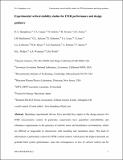Experimental vertical stability studies for ITER performance and design
Author(s)
Hutchinson, Ian H.; Wolfe, Stephen M.; Humphreys, D. A.; Casper, T. A.; Eidietis, N.; Gates, D. A.; Jackson, G. L.; Kolemen, E.; Leuer, J. A.; Lister, J.; LoDestro, L. L.; Meyer, W. H.; Pearlstein, L. D.; Portone, A.; Sartori, F.; Walker, M. L.; Welander, A. S.; Ferrara, Marco, Ph. D. Massachusetts Institute of Technology; ... Show more Show less
DownloadHumphreys_Nuc_fus.pdf (2.468Mb)
OPEN_ACCESS_POLICY
Open Access Policy
Creative Commons Attribution-Noncommercial-Share Alike
Terms of use
Metadata
Show full item recordAbstract
Operating experimental devices have provided key inputs to the design process for ITER axisymmetric control. In particular, experiments have quantified controllability and robustness requirements in the presence of realistic noise and disturbance environments, which are difficult or impossible to characterize with modelling and simulation alone. This kind of information is particularly critical for ITER vertical control, which poses the highest demands on poloidal field system performance, since the consequences of loss of vertical control can be severe. This work describes results of multi-machine studies performed under a joint ITPA experiment (MDC-13) on fundamental vertical control performance and controllability limits. We present experimental results from Alcator C-Mod, DIII-D, NSTX, TCV and JET, along with analysis of these data to provide vertical control performance guidance to ITER. Useful metrics to quantify this control performance include the stability margin and maximum controllable vertical displacement. Theoretical analysis of the maximum controllable vertical displacement suggests effective approaches to improving performance in terms of this metric, with implications for ITER design modifications. Typical levels of noise in the vertical position measurement and several common disturbances which can challenge the vertical control loop are assessed and analysed.
Date issued
2009-03Department
Massachusetts Institute of Technology. Department of Nuclear Science and Engineering; Massachusetts Institute of Technology. Plasma Science and Fusion CenterJournal
Nuclear Fusion
Publisher
International Atomic Energy Agency
Citation
Humphreys, D.A. et al. "Experimental vertical stability studies for ITER performance and design guidance." 2009 Nucl. Fusion 49 115003
Version: Author's final manuscript
ISSN
0029-5515
1741-4326